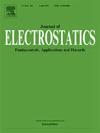Cascade properties of EHD wall jets generated by an actuator with distributed surface-embedded electrode pairs
IF 1.9
4区 工程技术
Q3 ENGINEERING, ELECTRICAL & ELECTRONIC
引用次数: 0
Abstract
Electrohydrodynamic (EHD) conduction pumps have become a high-quality solution for cooling high-power-density electronic devices in space domains due to their low voltage requirement and simple electrode distribution. Recently, driving environmentally friendly dielectric liquids, such as hydrofluoroethers (HFEs), using a cascaded actuator with distributed surface-embedded electrode pairs has gained attention as an innovative EHD cooling strategy. Previous studies have visualized the acceleration of the jet when it passes through each electrode pair by the PIV technique, and have experimentally verified the effectiveness of cascaded conduction pumps. However, the large time scale of these experimental studies makes it challenging to accurately capture the formation stage of the cascaded jet and thus explore its evolutionary properties. In this paper, a nine-surface embedded electrode pair actuator is modeled based on multiphysics field finite element method simulation. The results show that the four initial vortices above each electrode pair induced by charge migration undergo outer vortex expansion and inner vortex suppression within a short period, accompanied by merging, deflecting, and cascading processes of the localized jets. The vortices above each electrode pair show a consistent distribution pattern with the charge density extremes. The current density increases quasi-linearly over the voltage range of 0.5 kV–5 kV. With the operational number = 2.56 for the conduction pump in this study, the system consistently operates in the ohmic regime.
分布式表面嵌入电极对致动器产生EHD壁面射流的串级特性
电流体动力(EHD)传导泵由于其低电压要求和简单的电极分布,已成为空间领域高功率密度电子器件冷却的高质量解决方案。最近,使用具有分布式表面嵌入电极对的级联驱动器驱动环境友好的介电液体,如氢氟醚(hfe),作为一种创新的EHD冷却策略受到了关注。先前的研究已经通过PIV技术可视化了射流通过每个电极对时的加速度,并通过实验验证了级联传导泵的有效性。然而,这些实验研究的大时间尺度使得准确捕捉级联射流的形成阶段从而探索其演化特性具有挑战性。本文基于多物理场有限元法仿真,对一种九面嵌入式电极对作动器进行了建模。结果表明:电荷迁移引起的电极对上方的4个初始涡在短时间内发生了外涡扩张和内涡抑制,并伴有局部射流的合并、偏转和级联过程;每对电极上的涡旋与电荷密度极值呈一致的分布模式。电流密度在0.5 kV ~ 5kv电压范围内呈近似线性增长。在本研究中,传导泵的工作数β = 2.56,系统始终工作在欧姆区。
本文章由计算机程序翻译,如有差异,请以英文原文为准。
求助全文
约1分钟内获得全文
求助全文
来源期刊

Journal of Electrostatics
工程技术-工程:电子与电气
CiteScore
4.00
自引率
11.10%
发文量
81
审稿时长
49 days
期刊介绍:
The Journal of Electrostatics is the leading forum for publishing research findings that advance knowledge in the field of electrostatics. We invite submissions in the following areas:
Electrostatic charge separation processes.
Electrostatic manipulation of particles, droplets, and biological cells.
Electrostatically driven or controlled fluid flow.
Electrostatics in the gas phase.
 求助内容:
求助内容: 应助结果提醒方式:
应助结果提醒方式:


